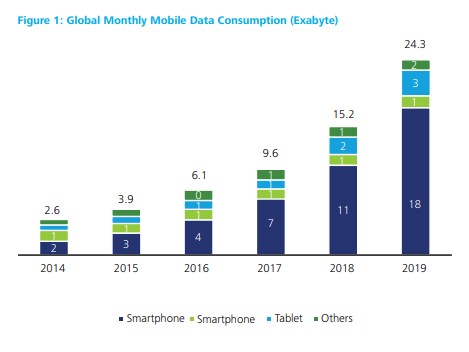With the relentless treadmill of disruption, the potential of media and entertainment companies to understand their customer’s digital consumption behaviour today is greater than at any time in history.
Among the digital devices, mobile devices have taken over as the preferred medium of consuming content online. The smartphone market has seen unprecedented growth in the last 5 years. Smartphone devices across the globe grew at a CAGR of 17% as compared to 9.5% growth in all mobile devices. Smartphones crossed 2 billion marks in 2014 and are expected to reach 4.6 billion by 2019.

This led to an increase in the number of devices capable of supporting digital media in tandem. Billions of screens and increasing internet access speed provided consumers with an option to access the media content of their choice anytime, anywhere.
Consumers are shifting their preferences towards digital media consumption as compared to traditional forms of media such as TV, print press, and radio. People are spending more time on digital forms of media rather than traditional mediums. This increase is mainly coming by cannibalizing traditional advertising mediums.
The increasing popularity of digital media has provided for a paradigm shift in global advertising spends. Marketers who are seeking to monetize content and capture growth are following the changing trend and increasingly allocating their budget to digital mediums. Spending on digital media as a percentage of total advertising spend has increased from 21% in 2010 to 28% in 2015 and is further expected to reach 36% by 2020.
Gen Z’s digital media consumption trends
Generation Z represents 1.8 billion people or 24% of the world population. Having an invigoratingly different attitude, Gen Z has a tremendous effect on the overall perception and digital media consumption.
They prove to be more entrepreneurial; growing up with search engines they like to discover content for themselves. They also like to be involved in the process, contribute to the solution and be more absorbed in experiences.
Though a wide range of digital consumption, the Gen Z capture insights from an array of sources. Translating these resources into viable products, services and business models will go a long way in defining the leaders of today and the leaders of tomorrow
Billion screens into digital consumption powerhouse
With a population of more than 1.3 billion and around 570 million internet subscribers, India has the world’s second-highest number of internet users after China; growing at a rate of 13% annually. India to overtake the US on time spent on digital videos. The global streaming platforms are looking to capitalize on the country’s fast-growing digital content consumption. The impressive scale of the market and a liberal foreign investment environment are strategically appealing to investors.

India is among the top five markets in the world based on the number of users for online and mobile gaming; with more than 90% of millennials preferring smartphones over gaming PCs and other devices. Besides, India consumes the highest data per user in the world. In 2019, adults in India, on an average spend 29.9% of their total daily media time on digital. In a recent report, the Telecom Regulatory Authority of India estimated the digital consumption of data to be around 7.69 gigabytes per month.
Leap through these Digital Challenges
India offers global investors enormous opportunities for growth. However, there also are several persistent challenges to consider before making the leap. Increasing use of digital media has accelerated video consumption, but it also has increased the piracy threat. In fact, growing piracy is likely to restrict the full monetization of content. As well as large-scale acceptance of subscription video on demand in India.
Digital advertising, a top-30 focus area of the industry, has lost as much as US$8 billion in revenues. Half of the loss incurs from “nonhuman traffic” — fake advertising impressions; that are neither generated by genuine advertisers nor received by actual consumers. The other half derives from a variety of factors such as ad-blocking and content infringements, like the sharing of passwords.
We provide innovative solutions for growth, customer engagement and streamline business processes.
Want to make the maximum of your brand?
Reach out to us at hello@mantralabsglobal.com
Knowledge thats worth delivered in your inbox




